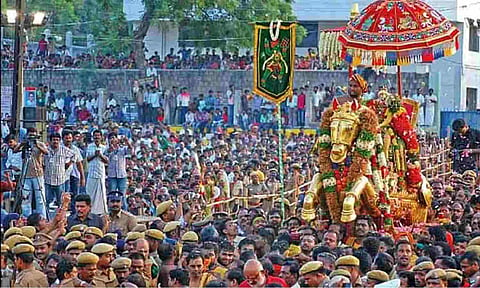

CHENNAI: Scorching heat and humidity notwithstanding, the Thamizh month Chithirai month (from mid-April to mid-May) holds immense significance for Tamil communities across India and beyond.
Despite soaring temperatures, Chithirai month is anything but barren. It’s a time when Mother Nature generously offers seasonal fruits and vegetables, and temples across Tamil Nadu resound with the sounds of chants, drums, and celebration.
The month is crowned by the world-famous Chithirai Festival in Madurai, a confluence of Saivism and Vaishnavism that draws thousands of devotees and tourists.
Spiritual landscape
The sacred calendar of Chithirai began with Amavasya (April 27), Akshaya Tritiya and Sathya Sai Baba Siddhi Day (April 30), and Adi Shankara Jayanti (May 2).
The 10-day Chithirai Festival began on April 29 in Madurai, a 10-day cultural and religious extravaganza that brings the city to life with pageantry and devotion. Central to the festival is the Meenakshi Thirukalyanam (May 8), the celestial wedding of Goddess Meenakshi, the fierce warrior princess and daughter of King Malayadwaja Pandyan, with Lord Sundareswarar (Shiva). This divine marriage is celebrated with elaborate rituals, vibrant processions, and communal festivities, reaffirming the goddess as the clan deity of the Pandyas.
On this day, Meenakshi is adorned with a garland of neem flowers, a symbolic link to the Pandyan dynasty.
Complementing this is the dramatic Azhagar Aatril Irangudhal (May 12), where Lord Kallazhagar, a form of Vishnu and Meenakshi’s brother, is believed to descend into the Vaigai River. According to history, Azhagar sets out from his hill temple to bless his sister’s wedding but arrives too late. This myth blends theological allegory with social symbolism, emphasizing the unity of Saivism and Vaishnavism.
The festival’s inclusive spirit was institutionalised during the reign of King Thirumalai Nayak in the 17th Century, who combined the once-separate Saivite and Vaishnavite observances into one grand celebration to foster communal harmony.
The Azhagar procession, originally conducted in Thenur on the north bank of the Vaigai River, was eventually shifted to Madurai, where it remains a major public spectacle to this day. Interestingly, the history claims that Lord Azhagar enters the river not merely for familial reasons but to atone for the curse of Manduka Maharishi.
Over time, multiple layers of myth and meaning have converged into a unified celebration.
Rituals, traditions, and community bonds
Chithirai also heralds the onset of Agni Nakshatram (from May 4), a period marked by extreme heat as the sun enters the fourth pada of Bharani and travels through Krittika to Rohini nakshatrams. Traditionally, this is considered an inauspicious time for weddings and new ventures.
Temples perform Tarabhishekam (sacred water rituals) to cool the deity and symbolically combat the searing heat. During this period, Neer Mor (spiced buttermilk) and Panakam (jaggery water) are freely distributed by households and volunteers as a gesture of community service and relief from the heat.
On the streets surrounding temples — known as Madaveethis and Rathaveethis — the air is festive with chariot processions, devotional music, and food distribution (annadhanam). Temples across Tamil Nadu, including those in Thanjavur, Srirangam, Samayapuram, Tirunelveli, and Thiruttani, hold grand processions and special rituals during Chithirai.
Notably, the Veerapandi Gowmariamman Temple near Theni celebrates the festival for eight consecutive days starting from the last Tuesday of the month.
The Chithirai Festival is more than a religious observance; it’s a tapestry of faith, folklore, social cohesion, and living heritage.
During the procession, Lord Azhagar appears in his distinct attire —turban, stone-studded kadukkan (earring), and black kangu sari —symbolizing his divine and royal persona. In a remarkable act of inclusion, a historical agreement allowed the deity to be presented in the form of a thief, acknowledging and integrating marginalised communities that once disrupted the event.
Under the reign of Vijayaranga Chokkanatha and others, the festival grew into an inclusive and expansive social phenomenon — featuring cattle fairs, public debates, and economic exchanges. Today, it continues to affirm the deep-rooted relationship between temples and their communities.
As the southern bank of the Vaigai resonates with Saivite devotion and the northern bank celebrates Vaishnavite grandeur, the Chithirai Festival stands as a glowing testament to the Tamil spirit—resilient, inclusive, and deeply connected to its roots. In every sense, Chithirai is truly the “festival of festivals.”
Honouring Kannagi: the fire of justice
The full moon day of Chithra Pournami is an auspicious day for worshipping Chitragupta, the divine accountant who keeps records of human karma. But it also shines a spotlight on Kannagi, the legendary heroine of the Tamil epic, Silappathikaram.
Having burned the city of Madurai in protest of her husband’s unjust execution, Kannagi wandered south. Tradition holds that she ascended to heaven from Vannathiparai, where the Mangaladevi Kannagi Temple now stands on the Tamil Nadu-Kerala border in Theni district. At nearly 5,000 feet above sea level, this temple is accessible only on Chithra Pournami and draws pilgrims seeking her blessings for justice and protection.
Kannagi continues to be venerated in Kerala, where she is known as Mangaladevi, Kodungallur Bhagavathy, and Attukal Bhagavathy, and in Sri Lanka, particularly in the districts of Batticaloa and Ampara. The Chellathamman Temple in Madurai remains the only one dedicated to Kannagi in Tamil Nadu.